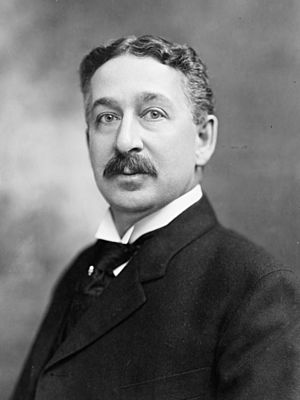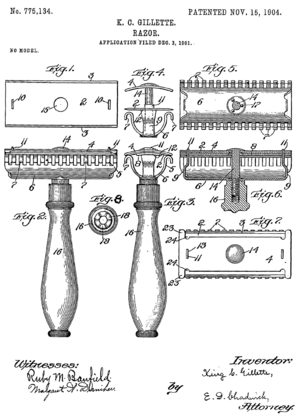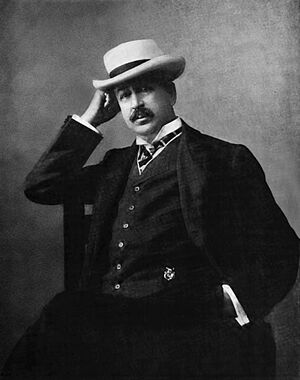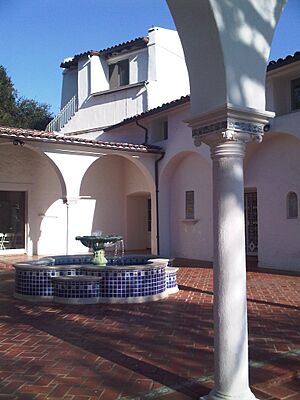King C. Gillette facts for kids
Quick facts for kids
King C. Gillette
|
|
|---|---|
 |
|
| Born |
King Camp Gillette
January 5, 1855 Fond du Lac, Wisconsin, U.S.
|
| Died | July 9, 1932 (aged 77) Los Angeles, California, U.S.
|
| Resting place | Forest Lawn Memorial Park Cemetery, Glendale, California |
| Nationality | American |
| Occupation | |
| Employer | Crown Cork & Seal Company Gillette Safety Razor Company |
| Known for | Inventing the double-edged safety razor, co-founding The Gillette Company |
| Spouse(s) |
Alanta Ella Gaines
(m. 1890–1932) |
| Signature | |
King Camp Gillette (born January 5, 1855 – died July 9, 1932) was an American businessman. He is famous for inventing a very popular version of the safety razor. Before Gillette's design, other safety razors existed. But Gillette's big idea was to create a thin, cheap, and disposable blade made from stamped steel. This made shaving much easier and more affordable for many people.
Contents
About King C. Gillette
Early Life and Family
King Camp Gillette was born on January 5, 1855, in Fond du Lac, Wisconsin. He grew up in Chicago, Illinois. His family was lucky to survive the Great Chicago Fire in 1871. His ancestors were French Huguenots, who were Protestants who had to leave France. They found safety in England, and later, some of them sailed to America in the 1630s.
The Big Idea for a Razor
In the 1890s, Gillette worked as a salesman for a company that made bottle caps. He noticed that people threw away the cork seals from bottle caps after opening a drink. This made him think about products that people use a few times and then throw away. He realized this could be a great business idea.
At that time, men shaved using "straight razors." These razors needed to be sharpened every day with a leather strap. The blades were expensive and quickly became dull. Gillette thought that a razor with a blade you could just throw away when it got dull would be very useful and popular.
Developing the Disposable Blade
Safety razors already existed in the mid-1800s. But they still used thick, forged blades. Gillette wanted to make a better design. His main improvement was a high-profit, stamped razor blade made from thin carbon steel.
The hardest part was making these thin, cheap steel blades. It was difficult to work with the steel and sharpen it properly. This is why it took some time from his first idea to the actual product. Steven Porter, a machinist, helped Gillette create the first working disposable razor. Later, William Emery Nickerson, another expert machinist, improved the razor's handle and frame. He also designed the machines to make the blades in large numbers.
Starting The Gillette Company
To sell his invention, Gillette started the American Safety Razor Company on September 28, 1901. In July 1902, the company's name changed to Gillette Safety Razor Company.
Production began in 1903. In that first year, he sold 51 razors and 168 blades. The next year, sales jumped! He sold over 90,000 razors and more than 123,000 blades. This success was thanks to Gillette's low prices, automated factories, and good advertising.
By 1908, the company had factories in the United States, Canada, Britain, France, and Germany. By 1915, razor sales reached 450,000 units, and blade sales were over 70 million! During World War I in 1917, the company even gave every American soldier a field razor set, paid for by the government.
Later Life and Challenges
King C. Gillette became very well-known. His picture was on every packet of razor blades. People were often surprised to learn he was a real person, not just a marketing image! In countries where English was not spoken, people would often ask for "the kind with the Man's Face" blades.
Sadly, Gillette faced financial problems later in his life. He spent a lot of money on property. He also lost much of the value of his company shares during the Great Depression. This left him almost bankrupt.
King C. Gillette died on July 9, 1932, in Los Angeles, California. He was buried in Forest Lawn Memorial Park Cemetery in Glendale, California.
His Ideas and Personal Life
King C. Gillette was also a Utopian Socialist. This means he believed in creating a perfect society. He wrote a book called The Human Drift (1894). In this book, he suggested that all businesses should be owned by the public. He also imagined a giant city called Metropolis, powered by Niagara Falls, where everyone in the U.S. would live.
He wrote another book, World Corporation (1910), which was a plan for a company to make this vision happen. He even offered former President Theodore Roosevelt a huge amount of money to lead this company, but Roosevelt said no. His last book, The People's Corporation (1924), was written with Upton Sinclair.
Gillette married Alanta "Lantie" Ella Gaines in 1890. They had one child, King Gaines Gillette.
In the 1920s, he built a home in Palm Springs, California. It had a large main house and a guest house. He was known to be a frequent guest at the Desert Inn in Palm Springs. The owner, Nellie Coffman, once said that Gillette had "practically kept this place in the black the last few years," even though he sometimes wandered around in an old bathrobe.
Gillette's Legacy
Today, the company King C. Gillette founded continues as the Gillette brand. It is now part of Procter & Gamble.
Gillette is often given credit for the "razor-razor blade business model." This is where a main product (like the razor) is sold cheaply to encourage people to buy the parts that need replacing often (like the blades). This idea helped change how many businesses operate.
The Gillette Company grew to sell products under many brand names, including Gillette, Braun, Oral-B, and Duracell. In 2005, the Gillette company was sold to Procter & Gamble for a huge amount of money: US$57 billion! It is now known as Global Blades & Razors, a part of Procter & Gamble.
King Gillette Ranch
In 1926, King Gillette bought a large property for a ranch in the Santa Monica Mountains near Calabasas, California. Famous architect Wallace Neff designed the buildings on the ranch in the late 1920s. The style was Spanish Colonial Revival.
After Gillette died, his wife sold the ranch to Clarence Brown, a film director. He held many Hollywood parties there. Later, Bob Hope bought the property and gave it to a Catholic Church order. It was then used as a seminary and later rented by Thomas Aquinas College. In 1978, another group bought it, and then Soka University of America (SUA) bought the land in 1986.
SUA planned to build a large college campus there. However, local residents, environmental groups, and government officials opposed the plans. They wanted to protect the natural habitats, open spaces, and an important ancestral site for the Chumash people.
Eventually, in 1992, a government agency used its power to buy the main part of the university land. This stopped SUA's expansion plans. After a long legal battle, Soka University moved to a new campus elsewhere.
The King Gillette Ranch was then bought by several government agencies for $35 million. They made it available for public use. On June 30, 2007, the 588-acre King Gillette Ranch opened as a public park. It is next to Malibu Creek State Park in the Santa Monica Mountains.
Since 2008, the ranch has been used as a filming location for the NBC reality show The Biggest Loser. It was also featured in the 2020 web television series Ratched.
Works
- The Human Drift (1894)
- World Corporation (1910)
- The People's Corporation (1924)
Images for kids
See also
 In Spanish: King Camp Gillette para niños
In Spanish: King Camp Gillette para niños




